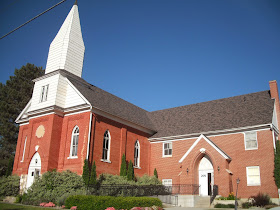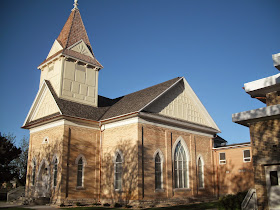Exploring & documenting historic temples, tabernacles and chapels of the Church of Jesus Christ of Latter-day Saints (also known as the LDS or Mormon Church).
▼
Monday, June 30, 2014
St. George Temple
The architecture of the St. George Temple, while less preserved than other temples (especially on the interior), is still beautiful to see.
Thursday, June 26, 2014
Manti Tabernacle
Dedicated in 1882, the Manti Tabernacle was originally an assembly hall that the congregation would divide with curtains in order to hold classes. Eventually, the congregation took out part of the hall to create a first floor that would hold classrooms. Later, an addition was put onto the west side of the building. Currently, the tabernacle is undergoing a renovation. This picture was taken just a couple of weeks before scaffolding and construction crews took over.
While the tabernacle wasn't open when I visited, I have been inside before. I was able to find a picture of the chapel on this site.
While the tabernacle wasn't open when I visited, I have been inside before. I was able to find a picture of the chapel on this site.
Tuesday, June 24, 2014
Monday, June 23, 2014
Three Mile Creek (Perry) Ward Chapel
Built in 1890, the Three Mile Creek Ward (later renamed the Perry Ward when the town's name was changed in 1898) building has stood for over a century. It was purchased by the local Heritage Theatre in 1975 after having stood vacant for several years. It's apparent that the building has undergone some changes:
(Source: Church History Library)
It's unfortunate that the tower has changed so drastically from its original appearance; the older version was much more authentic to the building.
(Source: Church History Library)
By the time this picture was taken, the newer tower was up. When the building was sold and converted to a theatre, the small, circular plaque above the main door was moved to a nearby park.
 |
| (Image Source) |
Thursday, June 19, 2014
Parowan Tabernacle: Interior
The museum housed in the Parowan Tabernacle is run by the Daughters of the Utah Pioneers. There is no charge to enter, and patrons can either take a self-guided tour or be given one from one of the society members. Patrons can even ring the bell in the tower by pulling on the rope.
Tuesday, June 17, 2014
Levan Ward Chapel: Wheat Stone Carving Detail
From what I could tell, these carvings were only on one corner of the chapel. I love the detail in them. I imagine that they are a tribute to the agricultural nature of Levan. They also bring to mind the symbolism given in the parable of the wheat and the tares.
Sunday, June 15, 2014
Parowan Tabernacle
(Source: Church History Library)
Years later, the Church gifted the building to the Daughters of the Utah Pioneers, and it currently holds a museum that is open from Memorial Day to Labor Day, 1-5 PM on every day except Sunday. It's a good example of members taking the initiative to save older buildings.Thursday, June 12, 2014
Levan Ward Chapel
Source: LDS Church History Library
Source: LDS Church History Library
Tuesday, June 10, 2014
Preservation Update: Chapel in Teasdale Demolished
Note: Preservation Updates are a regularly occurring series of posts
where I round up recent information on historic LDS buildings and their
futures. Depending on the age of the post, there may be newer
information available. Click here to see all Preservation Updates.
On June 6, the chapel in Teasdale, Utah was demolished. The Salt Lake Tribune reported that it was completed in 1947. It was a lovely building, and it's a shame it was torn down.

On June 6, the chapel in Teasdale, Utah was demolished. The Salt Lake Tribune reported that it was completed in 1947. It was a lovely building, and it's a shame it was torn down.
Source: LDS Church History Library
While the struggle between preservation and demolition may not be as controversial and widely known as in the days of the Coalville Tabernacle, it continues on. The lovely chapel in Paradise, Utah was demolished in 2013 (it's chapel walls included hand-painted flowers).
Source: LDS Church History Library
One of Parowan's older churches, constructed in 1928, was also razed in 2013.
Source: LDS Church History Library
And a stake center that was built during the Great Depression was destroyed just last month.
Source: Arizona Mormon News
Obviously, the LDS Church is still making tough decisions on which chapels to preserve and restore, and which ones to replace. While it may be easy for us to demand that all worthy architecture be preserved, it's difficult for the Church leaders to make those decisions with the usual demands of a growing Church. In many cases, the buildings either have no congregation to house (as in Teasdale) or would require significant upgrades and repairs that make it cheaper to build a new building.
In short, it is our responsibility as members of our communities to preserve pioneer architecture by making our desires known (respectfully), and, if necessary, offering to preserve it ourselves (as has occurred with structures in Heber, Utah; Blackfoot, Idaho; Parowan, Utah; and countless other locations). It's our duty--not the Church's.
Still, it's a complicated matter. The Teasdale community had developed a plan to repurpose the chapel as a museum and preserve the building, but the Church decided to demolish the building and give away the land. The Church always has concern on the future of its buildings--even when passed to a different owner--and in the past has shown a willingness to demolish buildings rather than sell them (and take the chance of them falling into disrepair).
Currently, I am working on a research paper on the demolition and preservation of LDS Tabernacles that highlight preservation trends and give specific examples. By the end of the summer, I hope to post a summary of the research in a series of posts in this blog. And let's keep an eye on the architecture around us, and do our part to make sure it's preserved.
Saturday, June 7, 2014
Thursday, June 5, 2014
Timpanogos Ward Chapel: Interior
I have found old interior pictures of the Timpanogos Ward from a ward history book. The original chapel used to look like this for much of the twentieth century:
There was a beautiful painting of the Susquehanna River at the front of the chapel, but it was covered up by a renovation in 1976.
The room now serves as a classroom, and a bigger chapel has been built onto another portion of the building.
It appears that in the renovation, the original room was cut off to form a hallway. It's not very deep; only about five pews fit in the middle section.
It's still a beautiful room, though.


























